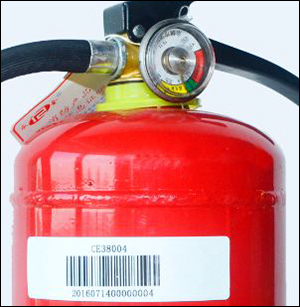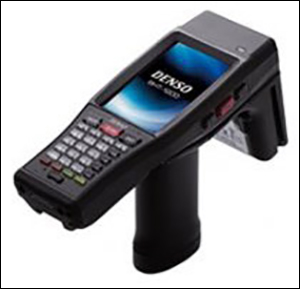The following are news announcements made during the past week by the following organizations:
Century RFID; Denso; STMicroelectronics, ams; the Auburn University RFID Lab, PLUS Location Systems; Infinite RF Holdings, L-Com; and GS1 Australia.
Century RFID Releases Commando IT Tag, Metalion L Printable RFID Label
RFID tag and label provider Century RFID has added two new passive ultrahigh-frequency (UHF) RFID tags designed for asset tracking and management. The Commando IT is a versatile tag designed for tracking servers, racks, data cartridges, cables and other IT assets, both metal and non-metallic, the company reports, while the Metalion L printable label, also intended for metal and non-metallic assets, is suitable for integration with existing bar-code or human-readable asset-tracking management, in real time and on demand. Both tags are compliant with the RAIN RFID, ISO/IEC 18000-6C and EPC Gen 2 RFID standards
The Commando IT (CE38006) measures 37.6 millimeters by 13.6 millimeters by 4.6 millimeters (1.48 inches by 0.54 inch by 0.18 inch) and uses Impinj‘s Monza 4QT chip, which contains 512 bits of user memory and 128 bits of Electronic Product Code (EPC) memory, in addition to a unique, serialized tag ID (TID). It has a unique attachment design that enables mounting via adhesive or strap.
The Metalion L (CE38004) is a printable label developed for very cost-sensitive asset-management applications. The label can be encoded and printed on demand using RFID-enabled thermal-transfer printers, or Century RFID can customize it with preprinting and encoding services. The Metalion L is made of PET and measures 97.5 millimeters by 27 millimeters by 0.9 millimeter (3.84 inches by 1.06 inches by 0.04 inch) and comes with Impinj’s Monza R6 or R6-P chip. It is delivered in roll format, is compatible with RFID-enabled thermal-transfer printers, and has a flexible design with strong adhesive for easy installation on flat or curved surfaces, according to Century Link. Customized pre-printing artwork, as well as bar-code and QR code printing are available.
Both tags have IP67 waterproof rating and free samples are available.
Denso Intros New Handheld Wireless UHF RFID Reader
Denso ADC, the Americas sales arm of Denso Wave Inc., has announced a new handheld wireless ultrahigh-frequency (UHF) RFID reader that can be used to scan multiple RFID-tagged goods from a distance of 16 feet or more.
The BHT-1281 RFID terminal complies with the ISO 18000-63 Type C and EPC Gen 2 RFID standards and can perform 360-degree scans for reading tags facing in different directions, the company reports, adding that when compared with scanning bar codes, using the BHT-1281 RFID reduces working time by up to 90 percent or more. Because its one-watt antenna allows the device to read standard UHF RFID tags at a distance of 16 feet or more, Denso ADC adds, the BHT-1281 can improve worker efficiency when tagged products are on high shelves.
The handheld features a comfortable pistol-grip handle and weighs about 570 grams (20.1 ounces), including the stylus and power pack, which contains dual extended-range lithium-ion batteries, enabling continuous scanning for eight hours or more. Communications capabilities include wireless local-area network (LAN) and Bluetooth. An optional device cradle enables a wired connection to a PC via Ethernet, USB or RS-232C. The handheld has an IP54 protection rating and is resistant to drops; the device is tested for drops from a height of 1.2 meters (3.9 feet) above a concrete floor, on all six faces, five times each.
STMicroelectronics Acquires ams’ NFC and UHF RFID Reader Assets
STMicroelectronics has announced that it has acquired the assets of ams, a global maker of sensor and analog solutions, related to ams’ Near Field Communication (NFC) and UHF RFID reader IP, technologies and product lines. The terms of the deal include an up-front cash payment of $77.8 million, as well as a deferred earn-out consideration contingent on future results of up to $37 million.
Through the terms of its deal with ams, ST says, it is acquiring the company’s intellectual property, technologies, products and businesses highly complementary to its secure microcontroller solutions serving the mobile devices, wearables, banking, identification, industrial, automotive and Internet of Things markets. Approximately 50 technical experts from ams have been transferred to ST.
According to STMicroelectronics, the acquired ams assets, combined with ST’s secure microcontrollers, position it for a significant growth opportunity, with a broader portfolio of technologies, products and competencies that address a range of the NFC and RFID markets for a wide customer base.
The first NFC controller, leveraging the acquired assets, is already sampling to lead customers, ST reports, along with a new high-performance, highly integrated system-in-package solution that combines this NFC controller with ST’s secure element.
Ams says the transaction is part of its ongoing efforts to actively manage its portfolio of technologies, with a clear focus on implementing its sensor solutions strategy. The divestment comprises ams’ NFC assets, including NFC front-end and antenna-boost solutions, and integrated high-frequency (HF) and ultrahigh-frequency (UHF) RFID reader assets. The related design and marketing resources are mostly based in Premstaetten, Austria, and Ljubljana, Slovenia.
Ams reports that it will retain its NFC and UHF RFID wireless tags business and related IP, and that it plans to create wireless sensor solutions for IoT applications combining NFC and UHF RFID connectivity interfaces with its portfolio of sensors. Alexander Everke, ams’ CEO, says that divesting certain NFC and UHF RFID product lines will streamline his company’s product and technology portfolio around its core sensor solutions competence, while maximizing the value of its high-performance wireless IP.
Auburn University’s RFID Lab Installs PLUS Location Systems’ RTLS
PLUS Location Systems, a provider of real-time location system (RTLS) and decision-support solutions, has announced a partnership with the Auburn University RFID Lab, to study Internet of Things technologies that leverage RFID and RTLS capabilities.
The Auburn RFID Lab is a research institute focused on the business cases and technical implementation of RFID and other emerging technologies in retail, supply chain and manufacturing, according to PLUS Location. The lab features 13,000 square feet of simulated retail, grocery, warehouse and distribution center environments, as well as academic and student expertise.
The lab has had a heavy focus on ultrahigh-frequency (UHF) RFID and the retail sector. But Justin Patton, the RFID Lab’s directory, says the lab is focused on a variety of technologies and open to all who would to include unique demos in the lab. “We have had active and RTLS systems in the lab for demo and research since our inception in Arkansas in 2006,” he states, “and have done quite a bit of research in non-RF areas as well, including computer vision and visual identification technologies. We have a research push in sensor fusion and RF fusion. Most new RFID applications are focusing on multi-sensor technologies, so we don’t plan to narrow our focus to UHF only in the future.”
According to Phil Yates, PLUS Location Systems’ VP of product development, organizations are trying to gain insight into the detailed behavior and interaction of all their employees, assets and inventory throughout their entire enterprise. This insight can be obtained by combining high-accuracy RTLS technology and low-cost proximity awareness in the appropriate areas, Yates says, and by integrating this data with that derived by existing RFID and other sensor systems.
PLUS has installed an RTLS in the RFID Lab to provide high-accuracy tracking throughout the facility. The solution includes a variety of hardware and software components, including active RTLS tags, which are worn by individuals or attached to assets, in addition to PLUS readers to receive the ultra-wideband (UWB) tag signals. The signals are processed by a suite of software applications to provide accurate, real-time locations, analyze the movements and interactions of tags, and provide access to the location data via a variety of dashboards, reports and application programming interfaces (APIs), according to PLUS. Additional Bluetooth Low Energy (BLE) beacons, app-based mobile devices and safety system elements will be added in the near future, the company reports. Faculty members at Auburn University will use the system to conduct research in the areas of warehousing and distribution, manufacturing and processing, hospitality, sports, emergency and military, and workplace and workforce. Additionally, the system will be demonstrated during regular tours of the RFID Lab, available by appointment.
Having the PLUS systems installed throughout the RFID Lab, Patton says, will enable its staff and students to study and characterize the activities and utilization of personnel and assets across a broad spectrum of use cases. The lab maintains a growing list of research projects that the PLUS solution will enable, he adds, resulting in new insights related to technology integration and the optimization of data collection and analysis tools and processes.
Infinite RF Holdings Merges With L-Com
Infinite RF Holdings, a supplier of engineering-grade radio frequency (RF), microwave and millimeter-wave components and cable assemblies through its Pasternack and Fairview Microwave branded lines, has announced its acquisition of L-com, a manufacturer of wired and wireless connectivity and sensor solutions with significant custom manufacturing capabilities. The merger is expected to expand both companies’ product portfolios, according to Infinite RF, as well as help Infinite RF to improve its ability to respond to customer requests worldwide.
According to Infinite RF, the merger creates a combination of solutions and a global footprint that provides an engineer with a broader spectrum of wired and wireless products designed to meet the urgent requirements of technical buyers. L-Com’s strong physical presence in China, the company reports, accelerates the establishment of a local Pasternack fulfillment center to deliver the full impact of its customer value proposition to the China market, while strengthening all of its brands in the Asia-Pacific region.
Headquartered in North Andover, Mass., with global manufacturing, sales and distribution operations, L-Com serves the wireless engineering community with short-lead-time design and product solutions. Its comprehensive offering includes wireless components, cable assemblies, antennas, specialized military and aeronautics connectivity solutions, and electrical connectors and wireless sensors for Internet of Things applications, through the L-Com, HyperLink, MilesTek, Aiconics and Point Six Wireless branded product lines (see L-com to Make, Sell Wireless Sensors from Point Six). L-Com’s HyperLink wireless products are designed for Wi-Fi, WiMAX, SCADA, 802.11a/b/g/n/ac, RFID and Bluetooth applications.
Infinite will continue to operate from its headquarters in Irvine, Calif.
GS1 Australia Launches Implementation Guidelines for Apparel, Footwear Sectors
GS1 Australia has launched a new set of guidelines designed to provide retailers and suppliers in the Australian apparel, fashion and footwear industries with best-practice guidance on RFID implementation based on global learnings.
The Apparel RFID Implementation Guidelines are designed to provide best-practice guidance to assist retailers, manufacturers and suppliers with the successful and cost-effective implementation of EPC-based RFID item-level tagging. In addition, GS1 Australia reports, they include instructions regarding the efficient identification, serialization and placement of a GS1 EPC RFID tag encoded with a serialized Global Trade Item Number (GTIN).
According to Sean Sloan, GS1 Australia’s manager of RFID and omnichannel, the adoption of EPC RFID using GS1 standards will give the Australian retail sector an opportunity to improve inventory accuracy throughout the supply chain, reduce out-of-stocks on the shop floor, boost sales, track individual items and deliver a faster check-out experience for customers at the point of sale. When implemented correctly, he says, RFID has the potential to significantly and positively disrupt an organization’s business.
The guidelines are based on GS1 Germany’s RFID Implementation Guidelines for the Apparel, Fashion and Footwear Sector 2015 and GS1 US’ EPC Based Guidelines for the Apparel Industry 2014, and have been localized for the Australian marketplace. Both Germany and United States have very mature and successful RFID programs in place with retailers, GS1 Australia reports, including Gerry Weber, Adler Modemärkte, Marc O’Polo, C&A and Adidas NEO in Germany, as well as Macy’s, HBC Group (Hudson Bay, Lord & Taylor, Sak’s), Dillard’s, Target Corp., Kohl’s, Sears Holdings, JC Penney and Walmart in the United States.
A copy of GS1 Australia’s Apparel RFID Implementation Guidelines can be downloaded at the organization’s website.



